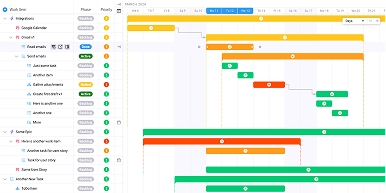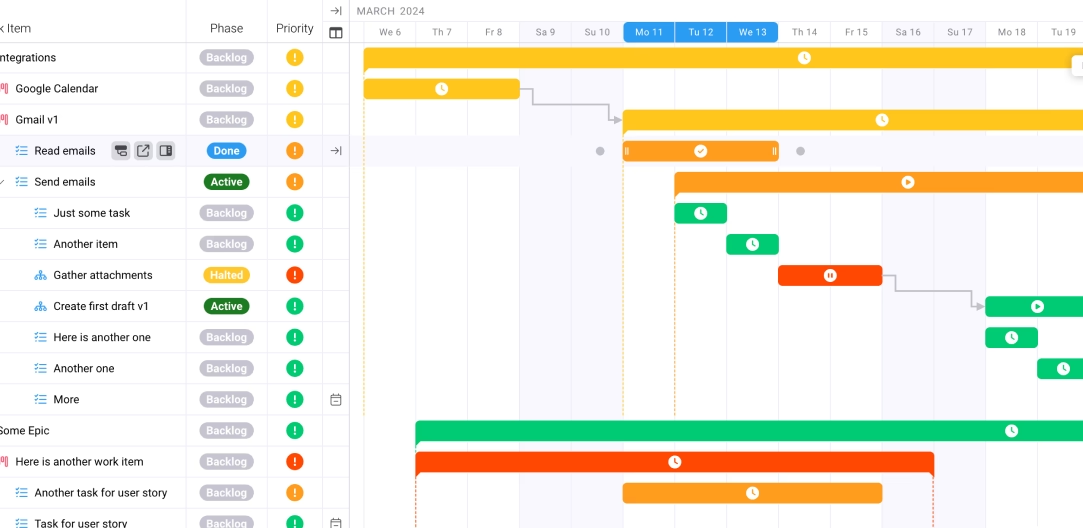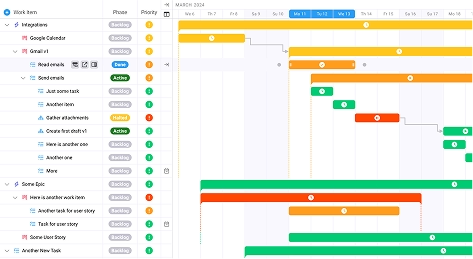
Streamline Your Agency: 12 Workflow Optimization Strategies That Save 20+ Hours Weekly
Key takeaways:
- Massive Time Savings: Implementing comprehensive workflow optimization can save 20+ hours weekly per team
- Proven ROI: Agencies using standardized optimization practices reduce operating costs by 10% or more
- Competitive Advantage: 80% of organizations will adopt intelligent automation by 2025, making early adoption crucial
- Measurable Impact: Strategic optimization addresses the core challenge that affects 40% of agencies—time management inefficiencies
While most agency leaders believe they’re running efficiently, the harsh reality reveals a different story. 51% of workers spend at least two hours per day on repetitive tasks that could be streamlined or eliminated entirely. For agencies juggling multiple clients, tight deadlines, and complex deliverables, these inefficiencies compound into a productivity crisis that’s costing both time and revenue. However, forward-thinking agencies are discovering that strategic workflow optimization strategies can reclaim massive amounts of lost time—with some businesses that implement workflow automation save an average of 20 hours per week.
The transformation isn’t just about working faster; it’s about working smarter in an industry where 40% of agencies cite time management as their top internal challenge. This comprehensive guide reveals 12 proven workflow optimization strategies that can revolutionize your agency’s operations and deliver the kind of efficiency gains that translate directly to your bottom line.
The Current Challenge – What’s Broken in the Agency World
The agency landscape is experiencing an efficiency crisis that goes far deeper than most leaders realize. U.S. companies lose $588 billion annually due to work interruptions, and agencies—with their collaborative, client-facing nature—are particularly vulnerable to these productivity drains.
The statistics paint a sobering picture of industry-wide inefficiency. Beyond the daily time waste on repetitive tasks, agencies face unique challenges that multiply these losses. Client communication gaps, project handoff failures, and resource allocation mismatches create a perfect storm of operational inefficiency.
The workflow automation market size is expected to reach USD 23.77 billion in 2025, indicating that businesses across industries are recognizing the urgent need for systematic process improvements. Yet many agencies remain trapped in legacy workflows that seemed adequate during smaller-scale operations but now act as growth inhibitors.
Research from Bain & Company reveals that more than a quarter of all companies can reduce their operating costs by 10% by using workflow optimization strategies. For agencies operating on typically tight margins, this level of cost reduction can transform profitability and competitive positioning.
The Strategic Framework – A Systematic Approach to Agency Optimization
Effective workflow optimization requires more than implementing random efficiency tools. Success demands a systematic approach that addresses the interconnected nature of agency operations. The framework centers on three core principles: elimination of redundancies, automation of repetitive processes, and optimization of human-centric activities.
The elimination phase focuses on identifying and removing processes that add no real value to client outcomes or internal efficiency. Many agencies discover they’re maintaining workflows simply because “that’s how we’ve always done it,” without questioning whether these processes still serve their intended purpose.
Automation targets the repetitive, rules-based tasks that consume disproportionate amounts of team time. This includes everything from client reporting and project status updates to invoice generation and resource scheduling. The goal isn’t to replace human creativity and strategic thinking, but to free up cognitive resources for higher-value activities.
The optimization phase enhances remaining manual processes to reduce friction, improve communication, and accelerate decision-making. This involves redesigning handoff points, clarifying role responsibilities, and implementing feedback loops that prevent small issues from becoming major delays.
Implementation Tactics – 12 Proven Workflow Optimization Strategies
1. Centralized Project Management Ecosystem
Replace fragmented project tracking with a unified project management system that provides real-time visibility across all client work. This eliminates the time waste of status meetings and email chains while ensuring nothing falls through organizational cracks.
Create standardized project templates that include all necessary phases, deliverables, and approval points. This consistency reduces project setup time and ensures teams never skip critical steps that could cause downstream delays.
2. Automated Client Communication Workflows
Implement automated client communication sequences that trigger based on project milestones, deadlines, or deliverable completions. This ensures clients stay informed without requiring manual intervention from account managers.
Design client portal systems where clients can access project status, provide feedback, and approve deliverables without email exchanges. This reduces communication overhead while improving client satisfaction through transparency.
3. Intelligent Resource Allocation Systems
Deploy advanced resource planning tools that provide real-time visibility into team capacity, skill availability, and project demands. This prevents overallocation disasters and ensures optimal utilization of your most valuable asset—your team’s time.
The key insight from comprehensive resource planning strategies is that effective resource management isn’t just about tracking hours—it’s about matching the right skills to the right projects at the right time to maximize both quality and efficiency.
4. Streamlined Approval Processes
Redesign approval workflows to eliminate unnecessary review cycles and clarify decision-making authority. Many agencies lose days or weeks waiting for approvals that could be streamlined through better process design.
Implement parallel approval processes where multiple stakeholders can review simultaneously rather than sequentially. This approach can cut approval time by 50-70% while maintaining quality standards.
5. Automated Time and Expense Tracking
Replace manual time tracking with intelligent systems that capture billable hours automatically. Modern solutions can track time across applications, websites, and project phases without requiring constant manual input.
Integrate expense tracking with project budgets to provide real-time profitability insights. This enables course corrections before projects become unprofitable rather than discovering issues during post-project analysis.
6. Document Management and Version Control
Establish centralized document repositories with automated version control and collaborative editing capabilities. This eliminates the confusion and time waste associated with multiple file versions and email attachments.
Create standardized naming conventions and folder structures that make finding documents intuitive for all team members. The time savings from improved findability compound significantly across large teams and long-term client relationships.
7. Quality Assurance Automation
Implement automated quality checks that flag common issues before deliverables reach clients. This includes everything from broken links and formatting inconsistencies to brand guideline compliance and technical specifications.
Design quality assurance checklists that integrate with project workflows, ensuring nothing bypasses essential review steps. This prevents costly revisions while maintaining high standards across all client work.
8. Client Onboarding Systematization
Develop standardized client onboarding sequences that collect all necessary information, set expectations, and establish working relationships efficiently. Proven time-saving strategies for agency project managers include creating onboarding templates that ensure consistency while reducing setup time.
Automate the collection of client assets, brand guidelines, access credentials, and project requirements through structured forms and workflows. This prevents the typical back-and-forth that delays project starts.
9. Integrated Financial Management
Connect project management with billing systems to automate invoice generation based on completed milestones or tracked time. This reduces administrative overhead while improving cash flow through faster billing cycles.
Implement real-time budget tracking that alerts project managers when spending approaches predetermined thresholds. This enables proactive project management rather than reactive damage control.
10. Strategic Vendor and Subcontractor Management
Establish standardized processes for working with external vendors and subcontractors. This includes streamlined onboarding, clear communication protocols, and integrated project tracking that treats external resources as seamlessly as internal team members.
Create vendor performance databases that track quality, timeliness, and cost-effectiveness. This enables data-driven vendor selection that improves project outcomes while reducing management overhead.
11. Knowledge Management and Training Systems
Develop comprehensive knowledge bases that capture institutional wisdom, client preferences, and proven methodologies. This reduces the time spent recreating solutions and enables faster onboarding of new team members.
Implement structured training programs that use actual client work as learning opportunities. This approach improves both individual capabilities and project outcomes while reducing the supervision time required for newer team members.
12. Performance Analytics and Continuous Improvement
Deploy comprehensive analytics that track key performance indicators across all workflows. Focus on metrics that directly correlate with time savings, such as project completion rates, revision cycles, and client satisfaction scores.
The insights from COOs can optimize project management for marketing agency growth emphasize that sustainable optimization requires ongoing measurement and refinement rather than one-time implementations.
Measuring Success – KPIs and Metrics That Matter
Successful workflow optimization requires measurement systems that track both efficiency gains and quality maintenance. The most critical metrics focus on time savings, error reduction, and client satisfaction improvements.
Time-Based Metrics:
- Average project completion time compared to historical baselines
- Reduction in administrative tasks as percentage of total work hours
- Time from project initiation to first deliverable
- Client approval cycles and revision rounds
Quality and Efficiency Indicators:
- Client satisfaction scores and retention rates
- Internal team productivity measurements
- Error rates and revision requirements
- Resource utilization and capacity optimization
Financial Impact Measurements:
- Cost per project delivery
- Profit margin improvements
- Billing cycle acceleration
- Overall operational cost reduction
Leading agencies track these metrics weekly and use the insights to identify bottlenecks before they impact client deliverables. The goal isn’t perfection—it’s continuous improvement that compounds over time.
Future Considerations – Emerging Trends and Next Steps
The future of agency workflow optimization lies in intelligent automation and predictive analytics. Artificial intelligence will increasingly handle routine decision-making, enabling human teams to focus on strategic and creative challenges that truly require human insight.
Machine learning algorithms will optimize resource allocation by analyzing historical project data, team performance patterns, and client preferences. This will enable predictive staffing that matches project needs with team capabilities more accurately than manual planning.
Integration between CRM systems, project management platforms, and financial tools will create seamless data flows that eliminate manual data entry and provide real-time business intelligence across all agency operations.
The agencies that begin implementing comprehensive workflow optimization strategies now will have significant competitive advantages as client expectations continue rising while talent acquisition becomes increasingly challenging.
Getting Started with Implementation
Begin your workflow optimization journey by conducting a comprehensive audit of current processes. Document how long each major workflow actually takes, identify the most frequent bottlenecks, and calculate the cost of current inefficiencies.
Prioritize implementations based on potential time savings and ease of adoption. Quick wins build momentum for larger transformations while demonstrating tangible value to stakeholders who may be skeptical of process changes.
Focus on integration and data flow between systems rather than individual tool optimization. The most significant efficiency gains come from eliminating manual data transfer between platforms and creating seamless handoffs between team members.
Most importantly, remember that workflow optimization strategies are not about eliminating human judgment and creativity—they’re about creating more time and mental space for the high-value work that drives client success and business growth. Organizations save an average of 18 hours per week when they implement comprehensive automation strategies, time that can be redirected toward innovation, client relationship building, and strategic planning.
The agencies that master these workflow optimization strategies will not only save significant time weekly but will also create scalable operations that support sustainable growth while maintaining the quality standards that drive client success.
Frequently Asked Questions
How long does it take to see results from workflow optimization?
Most agencies begin seeing measurable time savings within 2-4 weeks of implementing automation tools, with full optimization benefits realized within 90 days.
What’s the typical ROI for workflow optimization investments?
Agencies typically see 200-400% ROI within the first year, primarily through time savings that can be redirected to billable client work.
How do we maintain quality while optimizing for speed?
Quality maintenance requires building checkpoints and approval gates into optimized workflows, ensuring efficiency gains don’t compromise deliverable standards.
What happens if team members resist workflow changes?
Change management requires demonstrating clear benefits, providing adequate training, and implementing changes gradually to allow adaptation time.
Can small agencies benefit from workflow optimization?
Small agencies often see the most dramatic improvements because manual processes typically consume a higher percentage of their total operational capacity.
How do we choose which workflows to optimize first?
Start with processes that are highly repetitive, consume significant time, or create frequent bottlenecks in project delivery.
What’s the biggest mistake agencies make during optimization?
The most common error is implementing tools without redesigning underlying processes, resulting in automated inefficiency rather than true optimization.
How do we measure the success of optimization efforts?
Track time savings, error reduction rates, client satisfaction scores, and team productivity metrics compared to pre-optimization baselines.









